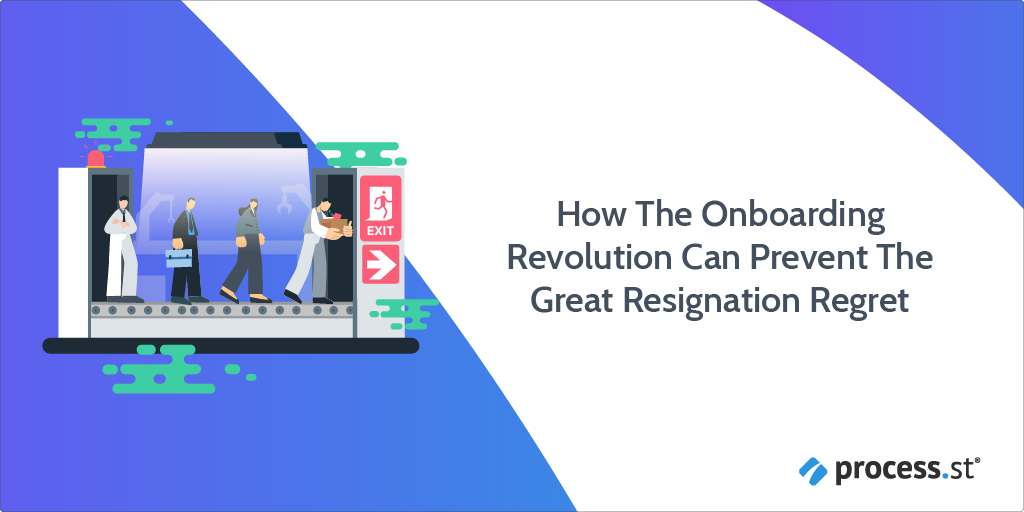
The Great Resignation has sent top talent searching for a better work-life balance. The Remote Takeover has made the job market exciting because the talent pool is the widest it’s ever been.
If you can’t give this migrating workforce the flexibility they want, you’re going to miss out on better productivity, improved well-being, and charged organizational performance: The Great Resignation Regret.
It’s easy to see why you don’t want this opportunity passing you by. So, how can embracing the Onboarding Revolution help prevent this from happening? That’s what we’re looking at in this Process Street article:
- The Great Resignation: Why are workers leaving?
- Incentives have changed – Welcome the Remote Takeover
- What opportunities does the Great Resignation present?
- How does the Great Resignation and Remote Takeover help you?
- Preventing the Great Resignation Regret with employee onboarding
Let’s get down to business!
The Great Resignation: Why are workers leaving?

Before we get into why onboarding has become more important than ever, we need to look at the catalyst that set everything into motion. Before COVID-19 was even a whisper, talks of remote working were starting to cause waves; but the outbreak of the pandemic amplified these talks. Rather than being a rare exception to the ‘normal’ in-office work, it was the only way most companies could continue to operate.
Working from home allowed for employees to experience a better work-life balance and gave them more flexibility during the day. Many employees also stated that their productivity remained the same or increased while working remotely. Approximately 77% of employees were more productive when working from home.
Workers became more comfortable working remotely – and discovered that they preferred it to in-office work. That’s why when it came time to return to the office, the long commute, the loss of work-life balance, and flexibility, they decided they would rather give in their notice and search for something more fulfilling.
“My employees are dropping like flies – what do I do?”
For the most part, employees are done with coming into the office 5 days a week, understandably so. If they can work from home and still be just as – if not more – productive, why should they return to the office?
Other companies are offering remote working options and increased flexibility. If you’re not, you can basically kiss away your top talent.
But that’s not all! We’re also seeing a new generation enter the job market. Similar to Millennials, Gen Z places a lot of importance on flexibility and work-life balance when picking a position.
Salary is still the most important factor, but Gen Z values this less than any other generation. Meaning, you’re going to need more than a competitive salary to keep the newer generation engaged at work. Of course, each employee’s reason for leaving is different. The bottom line is that unless you ask, you’ll never know what to do differently.
If you’re watching high-performing employees leave your company, you need to learn why. Is it because of a lack of flexibility? Maybe no career growth? What about a toxic work environment? Low pay? Speculation isn’t going to get you anywhere. Whenever an employee leaves, conduct an exit interview.
The beauty of an exit interview is that your resigning employee can be candid about their experience without any pushback or judgment. This is where you can understand why they’re leaving, and then use this feedback to make improvements so that your other top talent doesn’t leave.
Conducting an exit interview can become tedious when trying to cover all your bases. Use this premade employee termination workflow to streamline the process and help you spend more time making improvements.
Incentives have changed: Welcome the Remote Takeover
The Great Resignation has shown that times are changing, and job seekers’ priorities are changing with them.
With remote work becoming more popular, businesses can no longer rely on strictly in-office benefits (commute reimbursement, onsite fitness centers, free lunch on Fridays, and free parking) to attract top talent.
Let’s welcome the Remote Takeover.
What incentives should you be including during the Remote Revolution?
As I mentioned above, the times are changing. You’ve got to change with them. That means giving your potential employees what they want: Effective remote working options and increased flexibility.
It’s up to you to decide how to cater to these new working preferences. In some cases, you might need to offer online incentives to your existing workforce or invest in tools needed to support more remote positions.
Here’s an example of the perks offered when working remotely, courtesy of Process Street:
- Fully remote: No offices, no commute, check-in from a destination of your choosing!
- ⛱ Unlimited time off: Most take 3-4 weeks, plus recognition of days or events of their choosing.
- ✨ End of year week off: A company-wide week off to reflect and recharge.
- Annual company offsite: On pause during the pandemic, but we still sponsor small group meetups – safely and responsibly – to meet and build connective tissue.
- Health and wellness: Generous health, dental, and vision insurance for US employees and their families.
- Stock options: “Act like an owner” by owning equity as an early stage contributor.
P.S. if these incentives appeal to you, we’re hiring!
Setting up a remote workspace
One of the best ways of setting up your remote work culture is to set clear expectations and boundaries. You want to ensure your employees know what is expected of them when it comes to projects, work hours, and meetings.
This can help them feel more confident while maintaining expected productivity without going overboard. The most effective way to do this is by communicating your expectations through company policies.
When I first started at Process Street, I was presented with the company values. These gave me a good understanding of what was expected of me and how I could add value in my role. These are the values that help us maintain a productive remote work culture:
- Act like an owner: Show trust in the team and readiness to help.
- Practice prioritization: Be deliberate with how each hour is spent.
- Default to action: Ship it fast and often to accelerate learning.
- Pay attention to details: Be rigorous to ensure a great customer experience.
- Focus on the process: Reach success with efficient, flexible execution.
- Over-communicate everything, twice: Share thoughts with transparency and context.
What opportunities does the Great Resignation present?
The Great Resignation is the migration of employees resigning from their present positions and looking for more flexible working options.
This is only the first phase because after the Great Resignation, comes the Great Onboarding (or Re-Onboarding Revolution). If you’re ready to accommodate the remote work needs of these resigning employees, you can welcome them into your workforce.
You might think that adapting your organization to cater to these demands only benefits the employee. You’re doing all this work only to onboard a “demanding” workforce. However, this isn’t the case.
The Remote Takeover and Great Resignation also present exciting opportunities for businesses.
How does the Great Resignation and Remote Takeover help you?
Remote working has been given the reputation of being inefficient and problematic, but that simply isn’t the case.
When implemented correctly, your business can enjoy many benefits. Most of these advantages revolve around revenue, daily operations, and employee well-being.
More efficient communication
Process management solutions, like Process Street, help keep employees on the same page.
These BPM tools keep all business processes and resources in a centralized knowledge base. Approval and automation features streamline operations, saving time and reducing the risk of error.
Increased productivity
Telecommuting workers are between 20 and 25% more productive than those in-office.
Remote working offers more opportunities to take necessary breaks when the employee chooses, which psychologists believe boosts creativity, motivation, and overall performance.
This type of work model also has fewer social distractions for increased productivity.
Improved employee health and well-being
As we’ve mentioned, remote working helps improve work-life balance.
You empower your employees to customize their surroundings to their specific needs. They can choose how they wish to dress, plan how they want to spend their working hours, and set up their workspace for their preferred conditions. Having this freedom helps employees take care of their physical and mental needs.
In the beginning, many first-time remote workers might struggle to get set up properly. It’s always good to check in to ensure you and your employees are living a more balanced work-life, as this is the root to improved well-being.
You can use this workflow to help you achieve this healthy work-life balance.
Wider talent pool
Once you have a remote work culture, you’re no longer limited to hiring local job seekers. Your talent pool expands, which allows you to find talent with the right experience, skills, and personality who is best-suited for your business.
From here, you can start employing a well-rounded group of professionals from different cultures and countries to increase diversity without the hassle of having these employees packing up and moving.
Preventing the Great Resignation Regret with employee onboarding
The Great Resignation Regret is named that because if you can’t onboard this migrating workforce properly, you’re going to regret losing top talent. That’s because 64% of employees are likely to leave an organization after one year if their onboarding experience was negative.
When done wrong, onboarding can harm employee morale and performance, which pushes your top talent out of your organization. However, you can set your remote employees up for success when you have a well-designed onboarding process.
Strategically onboarding your top talent helps keep them engaged, boosting individual and organizational performance. When creating an onboarding process, you should remember what employees want during their first month of employment.
This includes:
- 1-on-1 meetings with their line manager;
- An outline of performance objectives;
- Plan for the first few weeks;
- List of people they should meet with;
- Interaction with the leadership team;
- Training materials;
- Shadowing.
Here’s a premade remote employee onboarding workflow that covers these expectations and helps get you started.
“If the Great Resignation has taught us anything, staff want to feel seen, heard, valued (compensation-wise), and appreciated.
So, there is a multitude of ways to do this – from a manager being trained on communicating to their staff through languages of appreciation to providing staff the ability to create their own employee resource groups – as those provide an opportunity for staff to be understood, where they might not be on their immediate team.”
– Jeff Harry, Founder of Rediscover Your Play
As Jeff Harry says, employees wanted to feel appreciated. Offering an engaging onboarding experience can do this.
However, onboarding is only the introduction into your company. You want your employees to grow with your business and have a say in how this growth takes place.
Career progression is a great focus area for achieving this. You can use this career progression template to help you get started.
What do you believe is most important to prevent the Great Resignation Regret? Let us know in the comments!







Grace Donaldson
Grace is a content writer with a thirst for knowledge and coffee. You'll find her reading in a small café or singing at a rundown jazz bar when she's not overconsuming coffee or compartmentalizing her thoughts into a blog post.